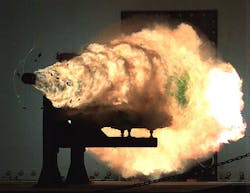Navy chooses L-3 to develop energy storage technologies for electromagnetic railgun
WASHINGTON, 21 Jan. 2016. U.S. Navy shipboard weapons experts needed energy storage technologies for the future electromagnetic railgun pulsed power system. They found their solution from L-3 Communications Applied Technologies Inc. in San Leandro, Calif.
Officials of the Naval Sea Systems Command in Washington have awarded a $7.1 million contract modification to L-3 Applied Technologies for four containerized battery energy storage and charging systems for the electromagnetic railgun pulsed power system.
The Navy's electromagnetic railgun project seeks to develop a long-range shipboard weapon that fires projectiles using electricity instead of chemical propellants. Magnetic fields created by high electrical currents accelerate a sliding metal conductor between two rails to launch projectiles at 4,500 miles per hour -- or nearly six times the speed of sound.
Supervising work on the Navy electromagnetic railgun are experts the Office of Naval Research in Arlington, Va.
As indicated by early prototypes, the electromagnetic railgun will use electricity generated by its host ship that is stored over several seconds in the pulsed power system. The weapon sends an electric pulse to the railgun to create an electromagnetic force accelerating the projectile to speeds as fast as Mach 6.
The weapons is designed to destroy targets with kinetic energy, rather than explosives. It would eliminate the hazards of high explosives in the ship and unexploded ordnance on the battlefield, Navy officials say.
On this contract modification L-3 will provide commercially based power supplies included in the battery and charging power supply prototype containers to charge the repetition rate pulse power for the railgun naval prototype demonstration.
In 2012 Navy experts tested a 32-megajoule prototype demonstrator, built by BAE Systems at the Naval Surface Warfare Center in Dahlgren, Va. General Atomics built a second launcher. General Atomics, BAE Systems, are working on a pulsed power system for the electromagnetic railgun.
Related: Electromagnetic railguns and high-power electronics: you ain't seen nothin' yet
When fully developed, the railgun will provide increased velocity and extended range over traditional shipboard weapons. The new weapon will be able to conduct precise, long-range naval surface fire support for land strikes; ship self-defense against cruise and ballistic missiles; and surface warfare to deter enemy vessels.
The Navy’s near-term goal is a 20- to 32-megajoule weapon that shoots a distance of 50 to 100 nautical miles. Navy officials want a rate of fire for the electromagnetic railgun of at least 10 rounds per minute. The pulsed power system will provide the electrical power necessary for this rate of fire.
On this contract modification L-3 Applied Technologies will do the work in San Diego and San Leandro, Calif., and should be finished by next June.
For more information contact L-3 Applied Technology online at www2.l-3com.com/ati, Naval Sea Systems Command at www.navsea.navy.mil, or the Office of Naval Research at www.onr.navy.mil.

